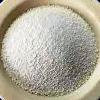| Anmol Chemicals is the pioneer manufacturers of Calcium Acetate, Pharmaceutical Excipients Fragrance & Flavor chemicals in India. We offer Halal and Kosher Sodium Acetate made in an ISO9001, ISO22000 (FSSC22000), cGMP and GLP certified facility. Our group has several manufacturing facilities spread across the world, supported by toll manufacturers and representatives in UAE, Europe, Africa, USA, China and has several associated manufacturing facilities spread across India. All the Information on Physics, Chemistry, Applications, Uses and Technology on Manufacture of Potassium Acetate is in these pages. |
| The units have one or more of the certifications like FDA GMP, ISO 9001, ISO 22000, HACCP, REACH, Kosher & Halal |
Calcium Acetate BP Ph Eur USP FCC Food Grade Manufacturers
The chemical compound calcium acetate is the salt of calcium and acetic acid. It has the formula Ca(C2H3O2)2. The anhydrous form is very hygroscopic; therefore the monohydrate (Ca(CH3COO)2•H2O, CAS [5743-26-0]) is the common form. It is used as a food additive, as a stabilizer, buffer and sequestrant, mainly in candy products. Calcium Acetate, (CH3COO)2Ca is used in food industry as a growth inhibitor for certain bacteria.
Calcium Acetate USP Grade
C4H6CaO4 158.17 --- [62-54-4]
Acetic acid, calcium salt.
Calcium Acetate contains not less than 99.0 percent and not more than 100.5 percent of C4H6CaO4, calculated on the anhydrous basis.
Identification: A solution (1 in 20) responds to the tests for Calcium and for Acetate.
pH: 6.3 to 9.6, in a solution (1 in 20).
Water: not more than 7.0%, determined in a 0.7-g specimen.
Limit of fluoride: the limit is 0.005%.
Arsenic: 3 ppm.
Heavy metals: the limit is 0.0025%.
Lead: 0.001%.
Chloride: 0.05%.
Sulfate: 0.06%.
Limit of nitrate: To pass the test.
Limit of aluminum (where it is labeled as intended for parenteral use or for use in hemodialysis or peritoneal dialysis)—
Barium (where it is labeled as intended for use in hemodialysis or peritoneal dialysis): the limit is 0.05%.
Limit of potassium (where it is labeled as intended for use in hemodialysis or peritoneal dialysis): the limit is 0.05%.
Limit of sodium (where it is labeled as intended for use in hemodialysis or peritoneal dialysis): the limit is 0.5%.
Limit of strontium (where it is labeled as intended for use in hemodialysis or peritoneal dialysis): the limit is 0.05%.
Readily oxidizable substances: Dissolve 2.0 g of it in 100 mL of boiling water, add a few glass beads, 6 mL of 10 N sulfuric acid, and 0.3 mL of 1 N potassium permanganate, mix, boil gently for 5 minutes, and allow the precipitate to settle: the pink color in the supernatant is not completely discharged.
Calcium Acetate BP, Ph Eur Grade
C4H6CaO4 --- 158.2 --- 62-54-4
DEFINITION
Calcium diacetate.
Content: 98.0 per cent to 102.0 per cent (anhydrous substance).
CHARACTERS
Appearance: White or almost white, hygroscopic powder.
Solubility: Freely soluble in water, slightly soluble in ethanol (96 per cent).
IDENTIFICATION
A. It gives reaction of calcium.
B. It gives reaction of acetates.
TESTS
pH: 7.2 to 8.2.
Readily oxidisable substances: Dissolve 2.0 g in boiling water and dilute to 100 ml with boiling water, add a few glass beads, 6 ml of 5 M sulphuric acid and 0.3 ml of 0.02 M potassium permanganate , mix, boil gently for 5 min and allow the precipitate to settle. The pink colour in the supernatant is not completely discharged.
Chlorides: Maximum 330 ppm.
Nitrates: Dissolve 1.0 g in water and dilute to 10 ml with the same solvent. Add 5 mg of sodium chloride, 0.05 ml of indigo carmine solution and add with stirring, 10 ml of nitrogen-free sulphuric acid. The blue colour remains for at least 10 min.
Sulphates: Maximum 600 ppm.
Aluminium: Maximum 1 ppm.
Arsenic: Maximum 2 ppm.
Barium: Maximum 50.0 ppm.
Magnesium: Maximum 5.00 × 102 ppm.
Potassium: Maximum 0.10 per cent.
Sodium: Maximum 0.50 per cent.
Strontium: Maximum 5.00 × 102 ppm.
Heavy metals: Maximum 20 ppm.
Water: Maximum 7.0 per cent.
Calcium Acetate FCC Food Grade
Ca(C2H3O2)2 Formula wt 158.17
INS: 263 CAS: [62-54-4]
DESCRIPTION
Calcium Acetate occurs as a fine, white, bulky powder. It is freely soluble in water and slightly soluble in alcohol.
REQUIREMENTS
Identification: A 1:10 aqueous solution gives positive tests for Calcium and for Acetate.
Assay: Not less than 99.0% and not more than 100.5% of Ca(C2H3O2)2, calculated on the anhydrous basis.
Chloride: Not more than 0.05%.
Fluoride: Not more than 0.005%.
Lead: Not more than 2 mg/kg.
Sulfate: Not more than 0.1%.
Water: Not more than 7.0%.
Calcium Acetate BP Ph Eur USP FCC Food Grade manufacturers:
Anmol Chemicals
S-8, SARIFA MANSION, 2ND FLANK ROAD, CHINCHBUNDER, MUMBAI 400009, INDIA
TEL: (OFFICE) 91-22-23770100, 23726950, 23774610, 23723564. FAX: 91-22-23728264
e-mail: anmolc@mtnl.net.in

Exports to USA, Canada, UAE, Dubai, South Africa, Tanzania, Kenya, Nigeria, Egypt, Uganda, Turkey, Mexico, Brazil, Chile, Argentina, Europe Netherlands, Italy, Spain, Germany, Portugal, France, Malaysia, Indonesia, Thailand, Korea, Vietnam, Japan, etc.
Product Links: Sodium Acetate --- Zinc Chloride --- Ammonium Chloride --- Calcium Chloride --- Potassium Chloride --- Sodium Diacetate




